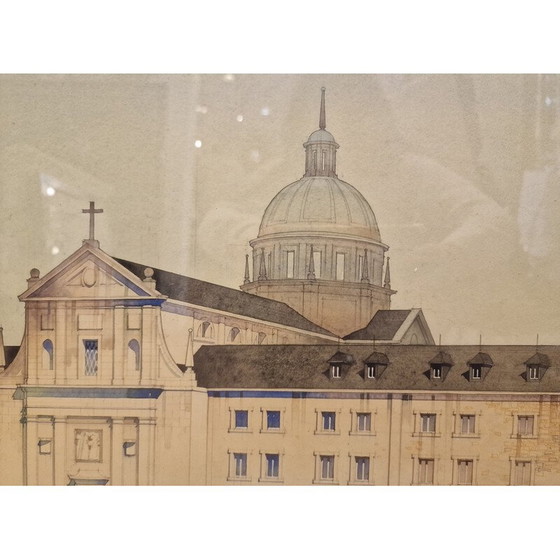Have it delivered hassle-freeBuyer protectionAll items curated by WhoppahDownload the Whoppah app here

Vintage painting “Elevation of the architectural project” by Luis Cervera Vera, 1970
Seller: Business seller€1,800Offer from €1,620
Item not as advertised, money backAll items are curated and 100% authenticHave it delivered hassle-free or pick it up yourselfShop only from Trusted Sellers
Business seller
Product description
Drawing / Watercolor “Elevation of Architectural Project” Luis Cervera Vera, 1970 – Madrid School
Exquisite elevation made by Luis Cervera Vera in 1970, signed in the lower right area. It is an architectural project where a classicist building is presented, with clear Herrerian ideals. Precise and technical drawing, carried out with a pencil and various tools, such as rulers and scalemeters; later completed with colored watercolors.
Cervera Vera was an academic and historian, as well as an architect. In his field of study he focused on classical architecture, especially Renaissance, both Italian and later Spanish. He investigated the basic treatises on architecture and showed great interest in the works of Juan de Herrera, a 16th century Spanish architect. This drawing represents precisely that, a construction of rigid mathematical proportions that characterizes the Renaissance style of the empire of Philip II. Another important feature is the slate spiers and geometric decorative elements (spheres and pyramids). Herrera, in his way of doing it, dissolves the figurative ornamentation, resulting in the culmination of the architectural volumes typical of classicism. The influence of his style, initially called disornamented and later Herrerian, will extend for almost a century and will have infinite followers.
The elevation of this building is projected axonometrically, that is, the three dimensions are illustrated simultaneously, incorporating notions of depth and spatiality in the drawing. Presumably it is a convent or hospice, belonging to a religious order, with a rectangular plan that in the middle of the axis presents the church, whose façade coincides with the symmetrical axis of the plan. Church of enormous classicism, Latin cross floor plan, large dome and Renaissance façade. The projection is completed with gardens and trees, colored with watercolor, as well as religious figures with dark habits.
Bibliography Luis Cervera Vera obtained from the Royal Academy of History
PhD in architecture from the Higher School of Architecture of Madrid, degree in Exact Sciences from the Central University and urban planning technician from the Institute of Local Administration Studies. He held several positions in the public administration, serving the Ministry of Finance and conservative architect of national monuments (General Directorate of Fine Arts), and was a member of the Advisory Board of Monuments and Historical and Artistic Ensembles (Ministry of Education and Science, 1983 ). As an urban planner and restorer of historical monuments, he stands out in the Lerma complex (Burgos), the school of Santa Cruz and San Gregorio in Valladolid, the churches of Santa María de Frómista (Palencia) and Lugareja in Arévalo (Ávila), or the Cathedral of Astorga (León). He was also a historian of Spanish architecture and urban planning. Pita Andrade (1998) divides his bibliographical production into five large sections: Felipe II, El Escorial, Herrera and other architects of the environment; town planning; the town of Lerma and its dukes; monographs on various architectural monuments; and important news about architects (Sabatini, Sagredo, Vitrubio, Mateo Vázquez, Lois de Monteagudo and Juan de Herrera, to whom he dedicated around fifty studies).
He was a full member of the Royal Academy of Fine Arts of San Fernando, proposed in 1975 to fill the vacancy produced in the Architecture Section due to the death of Luis Menéndez Pidal; The proposal was signed by Francisco Íñiguez Almech, Luis Gutiérrez Soto and Luis Moya Blanco. He was elected on June 30 and entered on April 4 of the following year, giving a speech On Plato's Ideal Cities, to which Luis Moya Blanco responded. In this institution he was censor (1977-1988), and president of the Publications Commission, in whose official magazine (Academia) he published numerous investigations; The same corporation awarded him the Conde de Cartagena Award and the González de la Peña in 1994.
Among his numerous distinctions, he was a corresponding academic of the Royal Academy of History and of Fine Arts of the Purísima Concepción of Valladolid, as well as corresponding (1978) and number (1987) of the Royal Academy of Fine Arts of Santa Isabel of Hungary of Seville, of honor of the Burgos Academy of History and Fine Arts of Burgos, and member of the Hispanic Society of America of New York, and of many other Spanish and American institutions. He held the commendation of number of the Order of Civil Merit.
An example of his bibliophile feeling was the large specialized library that he achieved over the years; He also assembled an important philatelic collection that was auctioned in New York. He founded a private center for the historiographical research of architecture and urbanism.
Specifications
ConditionGoodHeight123 cmWidth67 cmDepth5 cm











